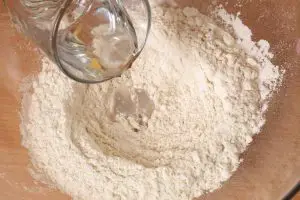There are certainly some benefits to using a Dutch oven to bake the perfect sourdough, but there are also some skills and techniques needed in order to use it safely and effectively. One of the main issues is transferring the dough into the Dutch oven, as this pot has deep sides with little room to navigate as the loaf is designed to fit snugly inside. The Dutch oven will usually have been pre-heated, making it incredibly hot to touch. This can make the process of carefully transferring the dough into the pot difficult as you must avoid these scorching edges. This can lead to some people resorting to dropping their dough into the pot from above, but this can knock the air out and which lessens the rise.
What are the best techniques for transferring sourdough into a Dutch oven?
1. Create a parchment paper sling
A safe and easy way to transfer your sourdough into a Dutch oven, is to create a sling out of parchment paper which you can use to carefully lower the dough into the pot. This will prevent you from burning your fingers and from knocking the air out of the dough, as it can be lowered with control. It is relatively quick to create the parchment paper sling and won’t impact the bake of the bread as it prevents the bottom burning by providing a thin barrier between the loaf and the pot.
The idea is that the parchment paper is wide enough for you to hold onto once the dough has been placed on top. This will allow you to lift the dough using the paper and carefully lower it into the Dutch oven. It is important to make sure the parchment paper does not stick out above the sides of the pot, as this can compromise the humidity and temperature properties of the Dutch oven.
- Take your parchment paper and cut out a rectangular, oval, or circular piece at least two or three inches longer than the proofing basket.
- The parchment paper should be cut to suit the shape of the loaf you are looking to bake, always ensuring there is enough paper on the edges, where you can create wings or a cross-like cut to provide extra support.
- One technique is to cut the paper into a rectangle and cut curves out of each corner to provide you with defined edges to hold on to.
- Take the parchment paper and put it over the bowl or proofing basket that contains your dough.
- Find a flat surface, like the bottom of a baking tray or a plate and place this face down on top of the parchment paper.
- Carefully, but quickly turn the bowl upside down while holding firmly onto the tray or plate.
- The dough will now be on the parchment paper on top of the tray.
- Remove the basket from on top of the dough but be careful to ensure the dough has not stuck to the edges as this could cause it to rip.
- Score the dough, then use the edges or wings of the parchment paper to lift it into the Dutch oven. It should be easy to lower the dough carefully and avoid burning your fingers.
- If you have a particularly wet dough, it may spread and flatten out once it is flipped onto the parchment paper as it is no longer supported by the edges of the bowl. The parchment paper may need to be cut slightly larger to account for this spread to make sure it stays contained.
2. Use two layers of parchment paper
If you do not have the time to cut out a sling, then you can use two layers of parchment paper to create a more significant heat barrier. This not only benefits your hands as you slide the dough into the pot without fear of hurting yourself, but also the loaf as it helps to prevent burning the bottom of the bread. If you use ground corn on the bottom of your pot to prevent the loaf directly touch the base, then the parchment paper layer will also stop this from imbedding into the bread.
- Lay the parchment paper over the bowl or basket that your dough has proofed in and trim to allow some overhang.
- Cover with a flat surface, like the bottom side of an oven tray or pizza tray, and invert so the dough is on top of the paper, on the tray.
- This flat surface will allow you to drag the dough over to the Dutch oven, and the double parchment will protect your fingers from burning.
- Then you can score the dough and place in the oven to bake.
3. Use a flat Dutch oven lid
If you find yourself without any parchment paper, it is still possible to transfer the loaf into the Dutch oven by using the lid, if it is flat. This is most effective for pots which are not too deep, and have relatively shallow edges, as this will minimize the chance of burning your fingers.
- Invert the lid of the Dutch oven onto your surface.
- Carry the loaf in the bowl or proofing basket and bring it over to the lid.
- Quickly and carefully turn the dough out of the bowl, onto the lid.
- Score the dough and place the Dutch oven pot over the top.
- Leave this upside down.
- Place in the oven and bake.
4. Buy a shallow, flat-based Dutch oven
If you are finding that transferring the dough into the Dutch oven is proving difficult, then you may want to invest in a shallow edged pot. It makes the process easier and safer, as you can lower with more control to prevent air loss and with less fear of burning your fingers. It also allows you to score the bread from within the pot and easily adjust the shape.
- Take your bowl or proofing basket containing the dough.
- Turn this out onto a flat surface by using a tray or a plate, holding it on top of the bowl and quickly inverting.
- Slide the dough from the tray into the shallow Dutch oven.
- Score and bake from within the pot.
5. Place the loaf in the Dutch oven before pre-heating it
This option should be tested as it will depend on the specific recipe you are using, and the type of oven you have. The idea is to place the dough within the Dutch oven before it is heated. This will allow you to position the loaf slowly, gently, and safely into the pot and result in a controlled bake.
There is a risk with not pre-heating the pot, as this can impact the bake time and could lead to a different end-product. This technique has been proven to be successful, resulting in the same loaf as if the pot had been pre-heated. It works well if the dough is not too wet and is a large loaf, fitting snugly in the pot, as it will retain its shape as the pot comes to temperature.
What is the best way of getting the loaf out of a Dutch oven?
This may seem like a simple question, but once your loaf has been baked it is good to know how to remove it from the Dutch oven. Simply lift the loaf out using the parchment sling, or by placing a tray on top of the cooled pot and turn it upside down. This will drop the loaf onto the tray, where you can position it the correct way round again. The last tip is to enjoy your well-baked loaf of sourdough.






